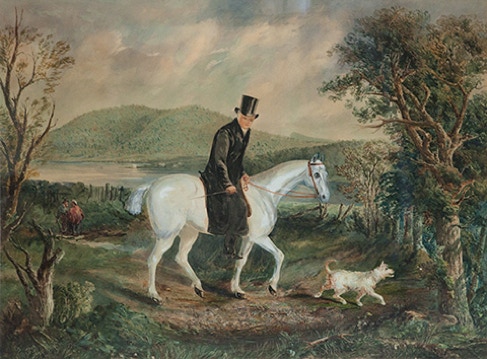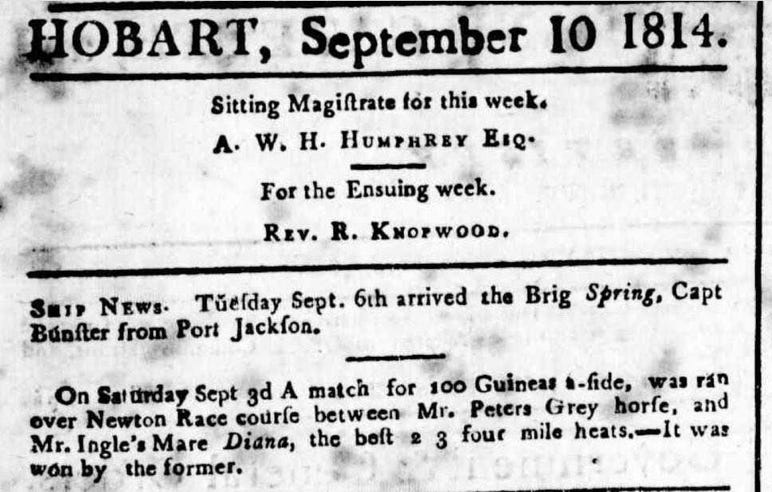1814 Hobart Town: Property deals, Horse races & a baby
HOBART 1814
Thomas Peters is named in a document for the ‘Re-assignment of Land in Van Diemen’s Land’. On 3rd February 1812 an agreement is made between Thomas Newby and Sarah Jones, for part use of a dwelling house and property in Elizabeth St. Hobart Town to be assigned to Private Stephen Reid and Sergeant Grant of the 73 regiment. This use is transferred from Sergeant Grant to Thomas Peters on 26th April 1814, and Peters then transfers his interests to Joseph Wright. (New South Wales, Australia, Colonial Secretary's Papers, 1788-1856 Series: NRS 898; Reel or Fiche Numbers: Reels 6020-6040, 6070; Fiche 3260-3312 via Ancestry.com)
- Thomas Peters signs this, and other documents, with his Mark. This is not a clear indication that he was illiterate. Often illiterate people learnt to sign their name, and until the late 1800s many literate people chose to use the X mark on legal documents.
- Thomas Newby and his wife Sarah Jones were Norfolk Islanders who were part of the second embarkation (the Porpoise) to leave Norfolk Island on for the Derwent, Van Diemen's Land on 26th Dec 1807.
- The New South Wales Corps (now known as the Rum Corps) was raised under the command of Major Francis Grose. After the Rum Rebellion, which occurred on 26 January 1808, the British Government sent Colonel Lachlan Macquarie to New South Wales along with his own regiment, the 73rd Regiment of Foot, the Royal Highlanders. All the officers of the New South Wales Corps were returned to England in disgrace in 1810. The 73rd Regiment - Royal Highlanders were in Tasmania from 1810 until 1814 when the order was given for the 73rd Regiment to embark to Ceylon. On 28 April 1814 Governor Macquarie reported to Earl Bathurst that he had ordered the Windham to go from Sydney to Hobart and thence Ceylon. Detachments stationed at Hobart at that time ‘being two Companies consisting of 220 men besides Officers, women and children’. The departure the of 73rd Regiment is the likely reason for the property exchange between Sergeant Grant and Thomas Peters on 26th April 1814 . http://www.bda-online.org.au/files/MR4_Military.pdf


Painting of Reverend Robert Knopwood (1763-1838). Attributed to multiple artists: landscape by Frank Dunnett, parson by TG Gregson, pony and dog by JW Graves junior. Courtesy: St David's Cathedral, Hobart. via Wikimedia Commons
…”Horse-racing was also popular. The few who could afford horses raced then against their neighbours’. A racecourse was formed on the government farm at New Town as early as 1810. Race meetings were established there in 1814 and quickly became a regular event.” Sharon Morgan, Land Settlement in Early Tasmania: Creating an Antipodean England (Cambridge University Press, Cambridge, 1992), 45.
…”Early racing consisted of one-against-one challenges, using horses not bred for racing. The first recorded race took place in 1813 at a course at New Town, when John Ingle raced his grey mare Whyena against the Hobart paymaster's black filly Sally for the best of three 2-mile heats, the loser to pay the winner 20 guineas. Such races became popular in both Hobart and Launceston, and developed as thoroughbreds for racing were imported from England from the 1820s.” http://www.utas.edu.au/library/companion_to_tasmanian_history/H/Horseracing.htm
Rev. Knopwood’s Diary, Saturday 16th July 1814:
“The day very fine; a sharp frost. At 12 I rode Mr. Birch’s mare to New Town to see the races between Lieut. Lassells grey horse Chivot, and Mr Ingles mare Diana for 200gs. which was won by Mr. Ingle, the best of 3 two mile heats. A great many ladies and gents were present. After that 2 more races, Mr. Mitchell black mare angst Mr. Peters’ grey horse - 1 four mile heat, won by the horse.”

The Van Diemen's Land Gazette and General Advertiser
Hobart September 10 1814. http://nla.gov.au/nla.news-article217484943
Rev. Knopwood’s Diary, Saturday 3rd September 1814:
“At home all morning. At 1 I rode to New Town to see the race between Mr Ingles mare Diana and Mr Peters horse - the best of 3, 4 mile heats, which was won by the horse. Mr. Ingle rode the mare and carried three stone and a half more than the horse. I dind at Mr. Whiteheads and rode home in the eve. The Lt. Governor at the races.
The records show that the Peters’ 7th child, Sophia Matilda, was born 20 Oct 1814. She was baptised in November 1814.
Research - Part B
29. RESEARCH Part B - A story of Thomas and Ann Peters.
30. RESEARCH Part B - Thomas Peters is transported for the term of his natural life
31. RESEARCH Part B - Mary Ann Peters accompanied her convict husband
32. RESEARCH Part B - 1803 Thomas, Mary Ann, & Elizabeth (2yrs) came to Port Phillip aboard the Calcutta
33. RESEARCH Part B - 1804 Peters family transferred to Van Diemen’s Land & Martha is born
34. RESEARCH Part B - 1805 Hobart Town: Mary Peters receives a Land Grant on New Town Rivulet
35. RESEARCH Part B - 1806 & 1807 The Peters have a farm with 4 cattle 2 sheep & a goat.
36. RESEARCH Part B - 1808 - 1812 Hobart Town: Martha dies, Thomas is pardoned, & 3 babies are born.
37. RESEARCH Part B - 1814 Hobart Town: Property deals, Horse races & a baby.
38. RESEARCH Part B - 1815 - 1816 Hobart Town: A juror, a boat race, supplying wheat & meat + 8th child
39. RESEARCH Part B - 1817 Hobart Town & York Plains: Thomas Peters receives a Land Grant
40. RESEARCH Part B - 1817 Hobart Town & Bagdad: the Duke of York & Baker’s farm
41. RESEARCH Part B - 1817 Hobart Town,York Plains, Bagdad & Tarrets’s farm
42. RESEARCH Part B - 1817 Hobart Town & Bagdad: Education, an executor, & stock moved from Herdsman’s Cove.
43. RESEARCH Part B - 1818 Hobart: A heavy cart and a ferry accident
44. RESEARCH Part B - 1818 Hobart: A court case, a house for sale. & Elizabeth marries George Armytage
45. RESEARCH Part B - 1818 Hobart: Stock on Birch’s land + Kickerterpoller & the Friendly Missions
46. RESEARCH Part B - 1819 Hobart: Rents to Supreme court & Mary Ann Peters (nee Hews) dies aged 39
47. RESEARCH Part B - 1819 - 1821 Hobart: Found guilty of ‘contumacious conduct in court’.
48. RESEARCH Part B - 1824 - 1829 Bagdad: Louisa marries John Hayes & Charlotte marries Francis Flexmore
49. RESEARCH Part B - 1830 Tasmania: The Black Line.
50. RESEARCH Part B - Nov 1930 Many Aborigines slip through the Black Line and the Peters house is raided.
51. RESEARCH Part B - 1830 Bagdad: As the Black Line advances settlers houses are attacked
52. RESEARCH Part B - 1830 Bagdad: Sophia Peters (16) and Ann Peters (14) are speared & Ann dies of her wounds.
53. RESEARCH Part B - 1830 - Following the Tasmania Wars the surviving traditional owners are rounded up
54. RESEARCH Part B - 1831 - 1839 Bagdad: Mary Ann Peters & Sophia Matilda Peters both got married,
55. RESEARCH Part B - 1839 Bagdad Thomas Peters dies
56. RESEARCH Part B - The 8 Children and 48 Grandchildren of Thomas & Mary Ann Peters
57. RESEARCH Part B - A Story of Thomas Peters and ‘the Brady Gang’
58. RESEARCH Part B - Where to next? Choices, choices, choices.


